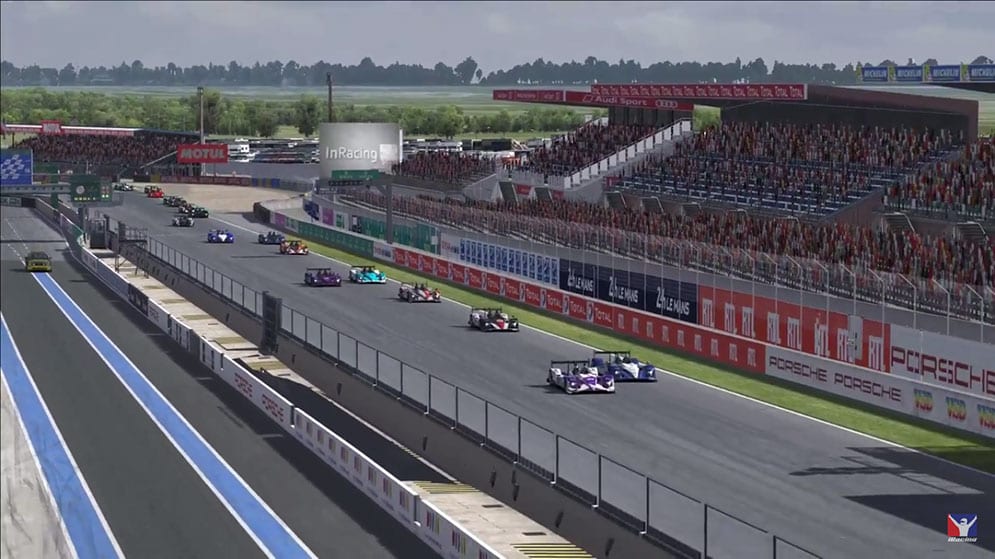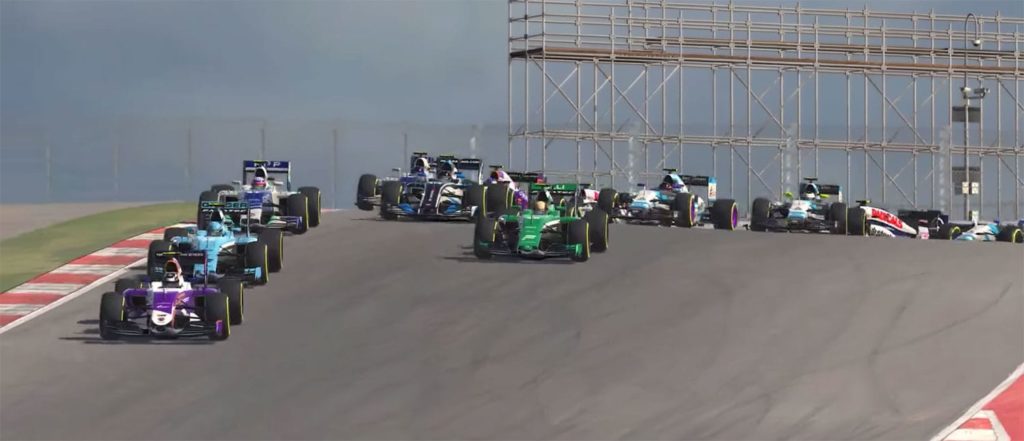Last weekend, eleven time Grand Prix winner Rubens Barrichello logged in on his computer from Brazil to compete in a simulator version of the 24 Hours of Le Mans, sharing the car with other drivers across the internet. In Argentina, reigning WTCC champion José María López did so too — together with almost two thousand other drivers.
Nine ‘versions’ of the race were held simultaneously, with teams running cars in the prototype, GT1 and GT3 classes. All across the internet, on a millimetre precise version of the famous Circuit de la Sarthe.

The start of the iRacing 24 Hours of Le Mans.
Today’s simulators are increasingly lifelike, with iRacing and its Le Mans event a prime example. Tracks are laser scanned, and cars are digitally built from the constructor’s technical drawings. Drivers can plug in a wheel, pedals and screens, although the top drivers have very professional ‘rigs’ at their home. The cast of real racers turning to simulators is growing with impressive names; Casey Stoner, Rubens Barrichello, Max Verstappen, Simon Pagenaud, Dale Earnhardt, Jr., Ryan Hunter-Reay, Juan Pablo Montoya, Takuma Sato and Nick Tandy have all confessed to turning to virtual racing to keep themselves sharp.
For example, here’s Stefan Johansson – former Mclaren and Ferrari Formula 1 driver – taking the 2015 McLaren around the Nordschleife.
But who was the eventual winner of iRacing’s 24 Hours of Le Mans? That would be Coanda Simsport.
It’s that same team that has also dominated many of the road series, winning iRacing’s 24 Hours of Daytona, the Blancpain Endurance World Championship, and the World Championship Grand Prix Series – the sim racing equivalent of Formula 1.
The way Coanda Simsport is run, together with many other sim racing teams, is probably more like a real racing team than you’d think. There’s numerous telemetry software in place, real sponsors feature on the cars, races are broadcast, and world championships are held with official regulations and with competitors from all over the world. We caught up with a few of Coanda Simsport’s members.
First, Jörn Jens, who’s thirty years old and who has been sim racing since 2010. Jörn won the Blancpain Endurance World Championship this year, together with four other drivers.
Jörn, how is a sim racing team structured? And how does it become successful?
“For our team, there’s not a huge hierarchy. We’re a close group of friends who are pretty focussed on what we do. Obviously, it’s a hobby for us, but we try to work professionally. Not many people see it, but behind the screens, we have to do finance, sponsor acquisition and paperwork. There’s also people managing the website, writing news articles and social media, and we have a graphic designer. It’s not just racing drivers.
And I think part of the success comes from that we don’t have all the drivers doing all the series. We’ve split the workload, and we have specific drivers who race GT3, and others who race in the Formula One series. This allows for a lot of focus.”
How do you prepare for races?
“It depends on the race. Ahead of the Blancpain season, we tested all the cars to see which one we wanted to race. We then practised more, tuned the car we chose (the BMW Z4 GT3). Because we share the car with each other, we all had to make compromises on the setup, so that we drive fast, but also be safe. Safety is more important in endurance races.
And unlike a real life racing team, we don’t have an engineer, so we have to create our own setups (which consists of hundreds of parameters). Equally, we don’t have a dedicated strategist, so we also have to figure that out ourselves too. That’s a big part of the preparation.”
How do you see sim racing evolve as a sport?
“It’ll grow, but probably there are a bit too many simulators around now. With games like CounterStrike or League of Legends, those are the big ones in that genre. In sim racing, we don’t have that. But I think sim racing is the truest-to-life form of e-sports. We have exactly the same input devices, we are racing by the same rules, and the cars and the tracks are all as accurate as they can be.”
David Williams, another driver of Coanda Simsport, is also a ‘virtual coach’ from the Virtual Racing School, teaching students on racecraft, including real life drivers. David is twenty-seven years old, and has been sim racing since 2007.

David demonstrating oversteer in the Mazda MX-5.
What’s it like coaching drivers via an online simulator?
“It’s different. With real life coaching, you sit next to your student and you can have a good understanding of what they’re doing right and wrong. In sim racing, you’re not physically there in the car with them, but you can read the telemetry and analyse the lap together. In terms of driving physics, sims are real enough that all of the rules of driving fast apply. For instance, the exact same way you’d bleed off the brakes to prevent a front lock-up in real life, you do the same in sim racing. In a game like Need for Speed, that wouldn’t be the case, because it lacks that depth of physics.”
When you started, could you have imagined that you’d be coaching drivers through the simulator?
“No. I’ve always hoped for sim racing to grow, but I never expected to coach anyone. Yet sim racing is growing now to the level that you can almost have a professional career in it. That wasn’t possible five or ten years ago. There wasn’t the audience for it.”
What do you love most about sim racing?
“I love how there’s no monetary element. Anyone can be competitive, spending less than a thousand pounds and yet still compete at the top level. That’s the great equaliser. There’s no buying your way to the top, so in that regard, it’s the purest form of motorsport.”
Another Coanda Simsport driver, Martin Krönke, is twenty-five years old and has been sim racing since 2007. This year, Martin won the top echelon of sim racing, the iRacing World Championship Grand Prix Series.
Sim racing: game or sport?
“I think sim racing, ultimately, is a mixture of both gaming and motorsport. We’re sitting behind a computer, so it’s gaming related. But based on how complex it is for a driver, it’s very close to the real thing, barring the lack of g-force. Most people don’t realise how physical sim racing is. The brake pedal requires about 100kgs of force, and the steering wheel 60 newton-meter, comparable to lifting twelve kilogrammes for several hours.”
What’s the biggest difference between a sim racing team and a real life racing team?
“Apart from the obvious things, I think the biggest difference is that we have nearly unlimited testing. We usually start practice two weeks before a race – log laps, try out different setups and get accustomed to the track. After maybe ten laps we dive into telemetry and see where we can gain time. We usually compare laps between the drivers of our team.”
Could you have imagined a world championship for sim racing, and also winning it?
“I imagined that there would be a world championship. Years ago, there was already a big championship and with a lot of money at stake. But it was unthinkable for me that I could ever win such a thing. I was good, but never the best. Now, after a lot of hard work and an almost scientific approach, it feels very special to have achieved this.”

Martin leads the field in the final race of the season at COTA.